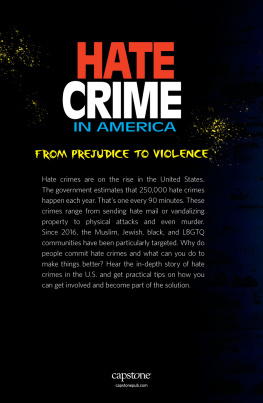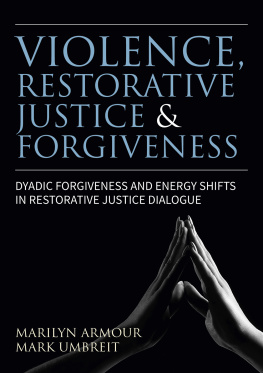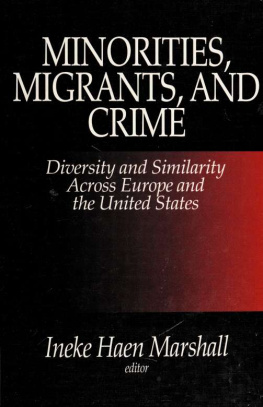In 1978, the Social and Demographic Research Institute of the University of Massachusetts, Amherst, received a grant from the National Institute of Justice to undertake a comprehensive review of the literature on weapons, crime, and violence in the United States. The purpose of the project is best described as a sifting and winnowing of the claims and counterclaims from both sides of the Great American Gun Warthe perennial struggle in American political life over what to do, if anything, about guns, about violence, and about crime. The review and analysis of the available studies consumed the better part of three years; the results of this work are contained in this volume.
The intention of any review is to take stock of the available fund of knowledge in some topical area. Under the Gun is no different: our goal has been to glean from the volumes of previous studies those facts that, in our view, seem firmly and certainly established; those hypotheses that seem adequately supported by, or at least approximately consistent with, the best available research evidence; and those areas or topics about which, it seems, we need to know a lot more than we do. One of our major conclusions can be stated in advance: despite the large number of studies that have been done, many critically important questions have not been adequately researched, and some of them have not been examined at all.
Much of the available research in the area of weapons and crime has been done by advocates for one or another policy position. As a consequence, the manifest intent of many studies is to persuade rather than to inform. We have tried to approach the topic from a purely agnostic point of view, treating as an open question what policies should be enacted with regard to gun, or crime, control. Thus, we have tried to judge each study on its own merits, on the basis of the routine standards normally applied to social-scientific research, and not on the basis of how effectively it argues for a particular policy direction. It would, of course, be presumptuous to claim that we have set aside all our own biases in conducting this study. Whether or not our treatment is fair and objective is clearly something for the reader, and not to decide.
With a few relatively unimportant exceptions, the work reported here does not add new evidence or data to this field of academic criminology. Our goal was not to strike out in new and innovative research directions, but to compile and assess the research work of others. The value of this undertaking lies in the wide coverage and critical assessment we have given to the topic of weapons and criminal violence in the United States.
We have defined the topic of the study in the broadest possible terms. Thus, we touch down frequently on issues that are only peripherally related to the more narrow question of the uses of weaponry in the commission of violent criminal acts. Exhaustive details on some technical points are thus sacrificed for wider coverage of relevant topics and, for this reason, we are certain to have overlooked at least some of the important literature. Indeed, the current version of the book includes discussions of, or citations to, a number of studies that were omitted in earlier versions. We do think, however, that all major studies are covered hereat least all major studies published as of early 1982.
Most of our criticisms of other studies are methodological in nature. We sought to determine if samples were drawn correctly, variables measured adequately, analyses performed competently, and so on. We fully recognize that standards of research are intrinsically relative in nature: if one adopts absolute standards of the pristine variety, then any piece of research can be dismissed. Dr. Johnson once remarked that patriotism is the last refuge of a scoundrel. Methodology may well be the first. This notwithstanding, although we have held the literature to high standards, we have not held it to unattainable standards, and have attempted to be realistic about the capabilities and limitations of current research methods in the social sciences.
Given the nature of our assessments, many of our conclusions are essentially methodological rather than substantive. Thus, we often conclude that there is no compelling evidence that or there are few data to suggest that. A critical but often overlooked methodological point must, therefore, be stressed in advance: the absence of evidence is not the same as evidence of absence. For example, one of our conclusions is that there is no compelling evidence that the private ownership of firearms among the general population is, per se, an important cause of criminal violence. This is not to conclude that guns are not a cause of crime, but rather that no one has yet persuasively demonstrated this to be the case. The unproved hypothesis is just that: unproved, not necessarily true or false.
The point is perhaps best made by example. At one stage in the history of human thought, it would have been perfectly true and in order for someone to conclude that there is no compelling evidence to demonstrate that the earth is round. Indeed, the very notion of a spherical earth would have, at one time, been grossly inconsistent with a mass of direct visual evidence. The absence of compelling evidence for the round earth hypothesis, however, does not make the flat earth hypothesis true! The skeptic whose conclusion is quoted above, in other words, did not conclude that the earth was flat, only that no one had yet demonstrated it conclusively not to be. To mistake the one conclusion for the other is an analytic error of the most basic sort.
Many of the conclusions reported in this volume turn on the rather thorny issues of inference and proof in the social (or, more generally, nonexperimental) sciences. We have made every effort to explain these issues in straightforward and nontechnical ways. Readers who are highly sophisticated in the methods of social research will find many of these discussions pedantic. However, our intent has been to write a book that is readily accessible to those without advanced methodological training. If the price of so doing is tedium among our more sophisticated colleagues, then we have struck an acceptable bargain.







